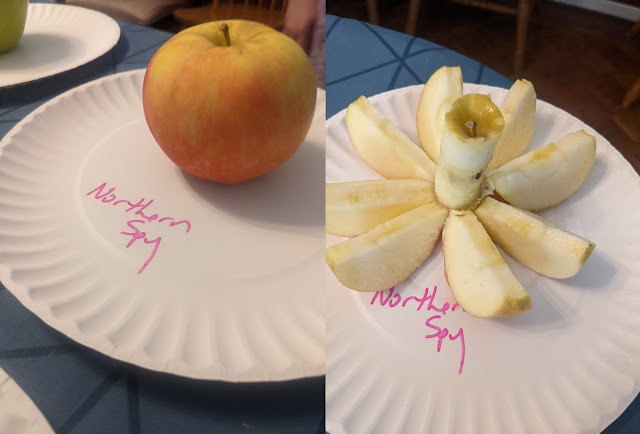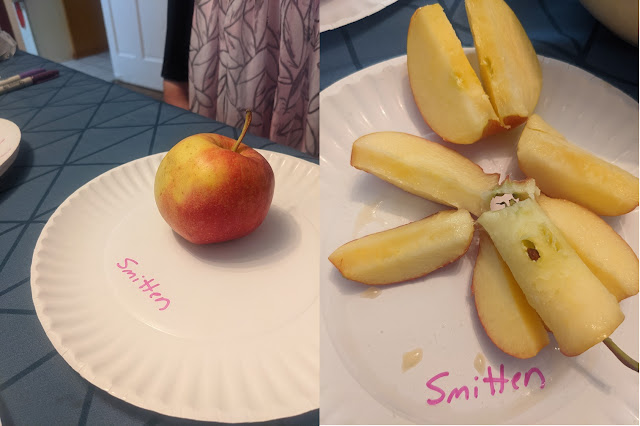It has been a crazy six months or so, but I didn't want to wait too long to post our first apple tasting! This took place in October of 2022 after we returned to Texas from our annual sojourn to Michigan for apples.
I have done smaller apple tasting before in the Apple Haus at Robinette's in Grand Rapids. I've also done some on my own after picking and before making sauce. But on those occasions, I was usually tasting 3-5 varieties of apples. This time, we tasted 12!
Once again, I used my crochet group as guinea pigs.
The varieties of apple we tasted were:
- Empire
- Fuji
- Honeycrisp (from 2 farms)
- Jonathan
- Ludacrisp (TM)
- McIntosh
- Mutsu
- Northern Spy
- Smitten (TM)
- SweeTango (TM)
- Zestar! (TM)
EMPIRE
Empire are probably my favorite eating apple. The flesh is usually marroon-red with green background. It has a very similar taste to McIntosh. Developed at Cornell University in 1940 from Old North American varieties McIntosh and Red Delicious, it is mostly grown in the northeastern US.
FUJI
Fuji apples are my go-to grocery buy. You'll notice that this one was actually purchased in a store in Texas (Kroger, probably) and not fresh picked in Michigan. I wanted a locally purchased apple for comparison.
Fuji apples are pink fleshed with yellow striations and are speckled. They are sweet and crisp. Originally cultivated in Japan, they were released to the general market in 1962. They are a blend of Rall's Janet and Delicious apples. They are also the number one apple purchased world-wide.
HONEYCRISP
You'll notice that there are two honeycrisps. Honeycrisp apples have gained fame in the US, possibly because they cost a little more than other varieties. People may think that makes them better, but it is probably because they tend to bruise more often and therefore need special shipping. The flavor is very pleasingly sweet but not complex.
I maintain that not all honeycrisps are grown alike. This, of course, it true for almost all produce- if you have a keen palette, you can taste differences in regions and weather conditions in most fruit and vegetables. I have had honeycrisp apples from dozens of places and picked them in 3 or 4 different states (Michigan, Wisconsin, Minnesota, and probably Washington, but I can't remember), and I can tell you that the best place I have found, HANDS DOWN, if Versluis Orchard in Standale, MI. To prove it, I picked a half bushel at our favorite orchard for picking and purchased a fresh picked half bushel from Versluis fruit stand.
Honeycrisps were developed by the University of Minnesota in the 1960s and hit the market in the 1990. They have a few offspring that are also well loved including...
LUDACRISP (TM)
Our first trademarked name, the Ludacrisp (TM) is large and red, very juicy with a slight tropical fruit taste. It is also known as the "Juicy-fruit apple" because it tastes a little like the gum. It was developed in the late 1990s in Ohio and was released to the public in the early oughts. It was created by open-pollination of honeycrisps.
JONATHAN
Jonathan apples are my favorite to sauce with. They are think skinned, mostly red with a hint of green. These are an American heirloom apple that was discovered in 1826 in New York. Jonathans are crisp and juicy, but don't take long to cook tender. I like chunky apple sauce (also good for pie filling) and usually use a blend of Jonathan apples and a tarter apple like Spy or Mutsu.
MCINTOSH
McIntosh apples are another favorite of mine. They are usually dark red with bright white flesh. They were discovered in Ontario, Canada in the early 1800s and was extremely popular for a long time. Macs are the father of many varieties. Crunchy and with a nice acidity, the flavor can fade quickly (around 10 days), so they are best fresh.
MUTSU
Mutsu are probably the only golden apples that I really like. Greenish-yellow, they tend to be large and rather irregular in shape. The crisp is subtle and the flesh is soft and grainy like a pear. The taste is honey-sweet with a tangy acidity. Mutsu were developed in Japan in the 1930s by crossing Golden Delicious with Indo apples. They are known there are the "Million dollar apple" and are called "Crispin" apples in the UK, where they were imported in 1968.
Mutsu apples are also great for baking and saucing. I have one tree growing in my yard here in Texas. We planted it last year, so I'll keep you posted on how it fairs in the heat.
NORTHERN SPY
Northern Spy apples are another large variety and are irregular in shape. They are ribbed and have streaks of orange-red on their yellow green background, making them really uniquely colored. They do bruise easily, though, so you won't find them often outside the northeastern US and Canada. The flesh is dense, yellow, and juicy with a sweet-tart flavor and a cider-like smell. For such a large apple, it also has a very small core.
Spy apples were first grown in Connecticut in the late 1700s. They were brought to NY and planted there in 1800. They did not get their name until 1840.
There are a few more reasons why the Spy is not popular outside of the smallish growing region. The trees have a low resistance to disease, can grow rather large, and sometimes will only produce every other year. Despite that, they are popular in some places and the slogan "Spies for pies" has been around for over 150 years.
SMITTEN (TM)
Smitten (TM) apples are another new variety. Cultivated in New Zealand in 1995, these apples have Gala and Braeburn in their family tree. Slightly greasy skin which has a slightly spicy smell opens up to a creamy yellow flesh that is crisp and moderately juicy. The taste is sweet with some acidity.
SWEETANGO (TM)
Another trademarked apple, the SweeTango (TM) was developed at the University of Minnesota from Honeycrisp and Zestar (TM) varieties in 1988. These apples are red and glossy with a thick skin and have a firm dense flesh. I also like their freckles!
ZESTAR (TM)
Our last apple is the Zestar (TM), another product of the University of Minnesota. Released in 1999, this apple had a yellow-green skin with orange-red striations, making it blush. It also has a matte finish to its skin. The flavor is sweet-tart with a hint of brown sugar.
All of the above information was found on OrangePippin.com and SpecialtyProduce.com.
Now for the tasting!!
I first made everyone a plate and put one slice of each apple on its proper wedge. That way, when you took a bite, you'd know just where to place it to remember which apple it was. The picture doesn't do the color difference justice. We had 7 adults and an unknown number of children taste the apples. I only recorded thoughts of the adults and my eldest girl (her opinion WILL be made known on pretty much anything... the apple doesn't fall far...).
Unlike when I did the pumpkin experiment and had lovely voting sheets, this time was a little more chaotic. I listened to the chatter and tried to take notes.
The favorite over all was the Smitten (TM). 4 adults voted for the Versluis Honeycrisp over the Schwallier Honeycrisp. They said the second was more watery. People had a love it or hate it reaction to the Mutsu. And all liked the SweeTango (TM). Lindsay (who grew up in Ohio) and I loved the Spy, but the southern ladies were less keen - except my friend Ashleah, who is from Amarillo.
A few more notes I made:
The Zestar (TM) held its color best- less oxidation. The Schwallier Honeycrisp went brown first. And the Empire was soft by the 5th week from picking, which was disappointing for me.
I will also say that the 4 trademarked apples were purchased pre-picked from Robinette's, the Fuji was from a store in Longview, TX, and the others were all picked at Schwallier's Country Basket in Michigan. The tasting took place about a month after we returned from our trip.
We cooked up about half the apples into a dozen quarts of sauce (plus one pint) and about a half dozen pints of apple butter. We sliced apples for about 8 pies and gifted or ate the rest. It is amazing how many people ask for apples when I go north! I may need to start bringing back 5 bushels!

















